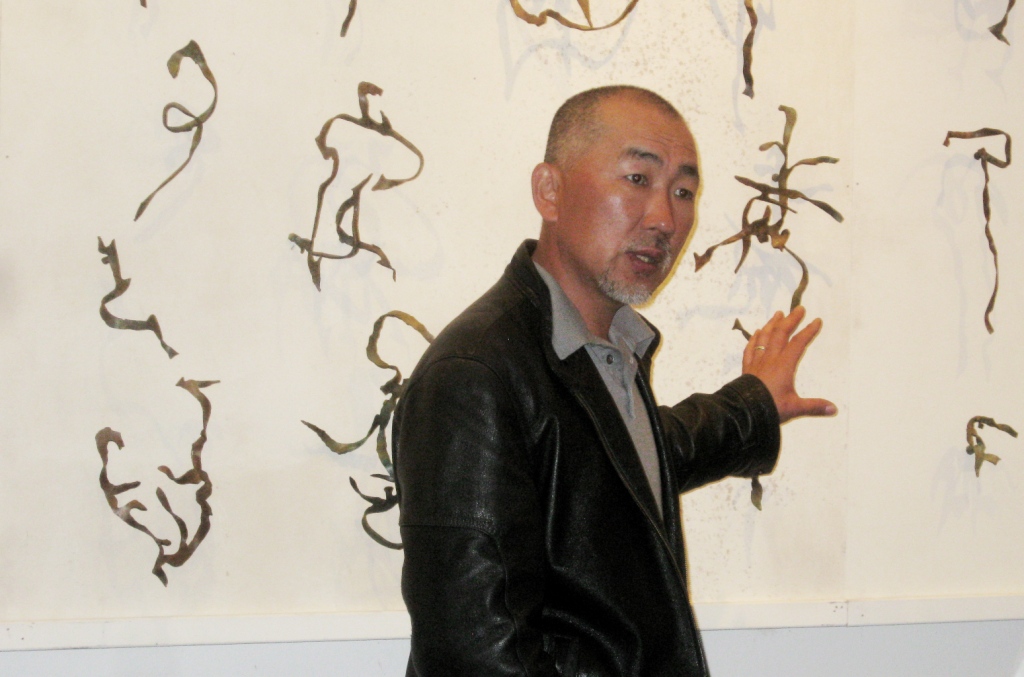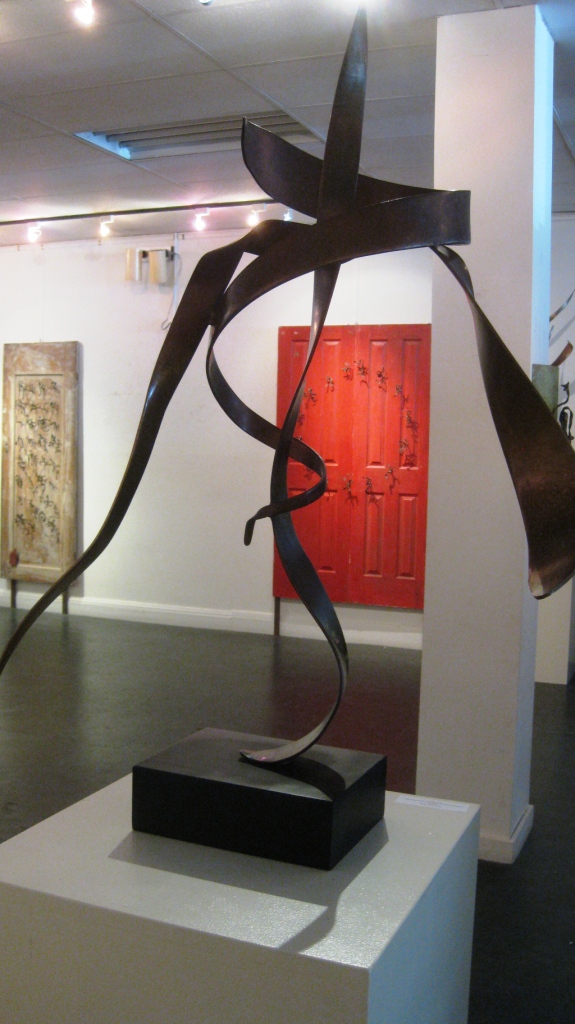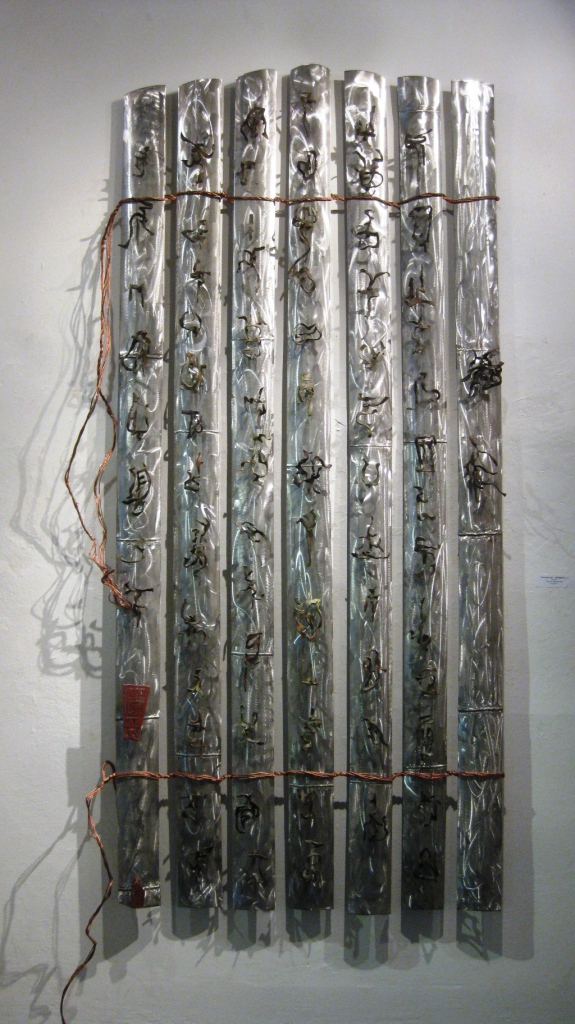The Tao is Up at Alameda Museum
March 17th, 2011
Feng Jin with Romancing the Metal, 2011. Copper and wood boards. Photo: Michael Singman-Aste
Having studied Japanese for two years at the University at California, Berkeley, there was a time when I knew several hundred Chinese characters. I know I’m rusty, but I can’t make heads or tails of Feng Jin’s characters. That’s just fine.
Although inspired by Chinese calligraphy, his work is not in fact a reproduction of Chinese verse in metal. Jin says that there are so many new words, in part because of the Internet.
“Let’s say this one called ‘peace,” he said, gesturing to one “character” at random. “You and me, we say ‘peace. My son, my family, all say that’s ‘peace.’ And today I don’t know how many people all say that’s ‘peace.’ Next time we saw this word we call ‘peace.’ So it’s a new mark … I want people to look at this one and not just say ‘Chinese word.’ You can see maybe Chinese guy made it. But nothing about Chinese.”
The solo show of Jin’s sculptures, “The Tao of Metal,” opened at the Alameda Museum on March 5. A reception was held March 12.
The fact that his “characters” are meant to be enjoyed purely aesthetically makes his work more accessible to a Western audience and gives them much broader appeal. Jin likens this appeal to the appreciation of Tang dynasty calligrapher Huai Su, whose “wild cursive” calligraphy is difficult even for Chinese speakers to decipher.
“He’s writing a lot of things that are just words. Nobody knows what’s that word,” Jin said. “A lot of professionals maybe know but a lot of people still don’t know. But we like it. We enjoy it because the lines, the stripes, the power, the space, whatever, they have a lot of professional beauty right there … Just like installation art, or modern art. Just art! That’s it.”
With the exception of a few freestanding sculptures studding the exhibit, all the work on display was created in the past year and a half, for which he fashioned 1,500 unique copper “characters.” Although not intended to retain their original meaning, a few of these pieces are in fact derived from actual Chinese characters.
“Sometimes I design using special pen, just writing Chinese word and cutting apart, but not too many,” Jin said. “And later bending the words to make new thing. You’d never know this was Chinese character. I just bending everything. But some pieces when I cutting the thing outside the line I still feeling the Chinese calligrapher.”
Many of Jin’s pieces are “signed” with a plate which bears his name in English crafted in a highly stylized script which resembles Chinese writing. Jin compares this to the work of another Chinese artist, Xu Bing, who both creates work in which English looks like Chinese writing, and also created his own series of faux-Chinese characters which he then used to print scrolls.

Feng Jin. Foreground: Root, 2008. Patina on stainless steel and painted steel base. Background, from left: Ci, 2011. Copper and wood door; Round & Completed, 2011. Copper and wood doors. Photo: Michael Singman-Aste
About half the pieces in the show are built upon doors. According to Jin’s statement, the door is “a background and an entry to introduce new form of Chinese calligraphy. Door not only represents ‘in vs. out,’ ‘open vs. close,’ ‘acceptive vs. rejective,’ but is also an entry in leading people to a new way, a way where either moving people forward or backward.”
Some of these doors were purchased secondhand. Others were traded by friends in exchange for brand new doors. He said to them “your door is beautiful,” to which they often replied, “I think it’s ugly.”
These door pieces range stylistically from the minimalist “Front Tooth” — a cracked white door with a black border bearing a single central copper odontoid piece — to his “Round & Completed,” two doors painted bright reddish orange with 15 copper pieces arranged in a circle. Jin said he intentionally steered clear of using 12 characters to avoid stereotyping the work and causing confusion with the Chinese zodiac.
- His “Neo-Bronze Age” stands out in gleaming contrast to the distressed doors.

Feng Jin, Neo-Bronze Age, 2011. Copper and stainless steel. Photo: Michael Singman-Aste
“This stainless steel looks like bamboo,” Jin said. “First, before Chinese make the paper they use bamboo or wood. And they use some kind of rope, just tie, like a book. From there I got some form. It looks like a bamboo book. And you look at this one (copper piece that) looks pretty old, maybe a thousand years ago somebody makes some work, and this (stainless steel) material is modern work. And it just makes modern/old contact.”
Jin’s beautiful sculptures with their faux-Chinese characters provide form without meaning, a framework upon which the viewer can attach significance. “The Tao of Metal” runs through March 30. Come see it for yourself. What do they mean to you?
The Alameda Museum is located at 2324 Alameda Avenue. Their hours are 1:30 p.m. to 4 p.m. Wednesday through Friday, 11 a.m. to 4 p.m. Saturday and 1:30 p.m. to 4 p.m. Sunday. The museum is closed Monday and Tuesday.
Michael Singman-Aste
Postdiluvian Photo
Tags: Alameda, Alameda Museum, Feng Jin, The Island



Nice review for my exhibition. Thank you for your good work.